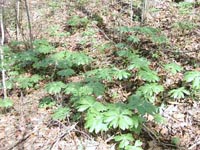Resource Library
Plant of the Week: Mayapple
The University of Arkansas System Division of Agriculture does not promote, support or recommend plants featured in "Plant of the Week." Please consult your local Extension office for plants suitable for your region.
Plant of the Week
Mayapple
Latin: Podophyllum peltatum

Mayapple is one of the most noticeable of our early spring wild flowers, not because of the flowers, but because of the large colonies of leaves produced in the woodlands. While a few gardeners criticize it for its wandering ways, most embrace it as a free spirited wanderer amongst the tree trunks.
Mayapple (Podophyllum peltatum) is one of the herbaceous members of the barberry family. It can colonize a large area by means of its underground rhizome. It occurs naturally throughout the eastern woodlands.
Seedling mayapples spend their first four years of life with a vertical root system and just a single leaf. After the fourth year, the lower portion of the vertical root develops an axillary bud that begins to grow horizontally. At the end of this rhizome, a resting bud forms, and the following spring, a new leaf emerges from this bud. Once the knee-high, umbrella-like leaf emerges one or more buds at the base of that leaf begin growing, subsequently terminating in resting buds for the following spring. The following spring, the old bud and the new buds will all have leaves.
During the first several years, the mayapple leaf is round and unbranched, too juvenile to flower. When adulthood is reached, the stem -- most authorities agree it is a stem, not a petiole -- terminates in a "Y" shaped fork with two leaves. Nestled in the fork is the single, white mayapple flower.
The fruit is a berry about the size and shape of an egg with a thick yellow rind. Fruit only form when the flowers are cross-pollinated, so colonies that typically produce fruit probably arose from more than one seedling. When ripe, the edible fruit gives off a strong fruity smell. It is suggested for jams and marmalades, but I have yet to meet anyone who actually has eaten mayapple preserves.
The first European encounter with mayapple was in 1615 when the French explorer Samuel de Champlain encountered the plants being cultivated by the Huron Indians in modern day Canada. It is believed that the mayapples found in Canada today are there because of Indian cultivation after the last ice age.
The Cherokees use the roots in traditional medicine but caution that only those portions of the rhizome between the nodes should be used, as the joints are poisonous. They use boiled root as a purgative, a drop of fresh root juice to cure deafness and powdered root to cure various ulcers and sores.
Modern medicine has found that an extract of dried rhizomes called podophyllotoxin blocks cell division, so it has been used extensively as a base for several anti-cancer drugs. An extract is also used topically to treat genital herpes. In 1970, 130 tons of the roots were harvested in the US. But about that time, it was discovered that a related Himalayan species had a higher concentration of the drug -- and the labor rate in northern India is incredibly cheap -- so buying moved to southern Asia. Today, that species, P. emodi, is nearly extinct in the wild so there is interest in developing sustained cultivation of the American mayapple.
While only one species of mayapple is found in the New World, a baker's dozen are found in southern Asia and western China. These wild mayapples are finding their way into cultivation thanks to the efforts of plantsmen such as Dan Hinkley at Heronswood Nursery in Washington.
Our native mayapple is easy to grow in the garden. Any reasonably fertile, well- drained site will work. They prefer areas that are moist in the spring, but summer drought does not bother them in the least because, when it gets too dry, their leaves die away and await another season. They'll grow in full sun, but to my mind, they always look a bit exposed in sunny locations. Propagation is easy by early spring division.
By: Gerald Klingaman, retired
Extension Horticulturist - Ornamentals
Extension News - May 9, 2003
The University of Arkansas System Division of Agriculture does not maintain lists of retail outlets where these plants can be purchased. Please check your local nursery or other retail outlets to ask about the availability of these plants for your growing area.